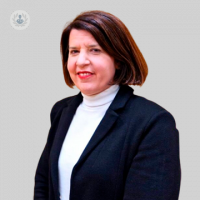What is perimenopause?
Perimenopause, sometimes also called the ‘menopause transition’, is the period leading up to the menopause. Menopause, which is the more well-known term, is the medical definition of the permanent end of menstrual cycles.
Perimenopause starts when the first features of approaching the menopause occur such as menopausal symptoms and menstrual changes, and ends 12 months after the last menstrual period.
During perimenopause, the ovaries produce less oestrogen and other hormones and the levels can fluctuate. Eggs are released less regularly and the body becomes less fertile. Having said that, pregnancies may still happen in perimenopause.

What are the first signs of perimenopause?
Typically, the first signs of perimenopause are changes in the menstrual cycles; periods may become irregular and longer. Perimenopause is also associated with a variety of symptoms, including:
- Hot flushes/flashes
- Mood swings
- Anxiety
- Joint pains
- Headaches
- Sleep problems
- Weight gain
- Poor concentration
- Low libido
- Vaginal dryness
- Bladder symptoms such as urgency, leakage, getting up at night
Symptoms may come and go, and periods may be regular, which can be confusing. Every woman will experience the perimenopause differently and for some it can be very difficult to cope with. An individualised approach is paramount.
What is the typical age of perimenopause?
Perimenopause may start years before the menopause and the average age of menopause in the UK is 51. Typically, most women enter the perimenopause in their 40s. However, for some it may begin in their 30s.
What are the stages of perimenopause?
In medical terms, and under the STRAW staging system, there are three stages of perimenopause, which are defined in relation to the last menstrual cycle. The third stage below (c), actually covers the period after the menopause:
- Early menopausal transition (stage -2)
This is the stage when hormone levels may start fluctuating and menstrual cycle length may become longer and irregular.
It may start a number of years before the menopause occurs.
- Late menopausal transition (stage -1)
In this stage irregular cycles become more common and there is at least one episode of no bleeding for 60 days or more.
This stage may last 1 to 3 years before the menopause.
- Early postmenopause (stage 1a)
This is the stage straight after the menopause. During this stage, there are no menstrual cycles and lasts for 12 months.
How is perimenopause treated?
Every woman will experience the perimenopause differently and not everyone needs to be treated. Perimenopausal symptoms may vary from very mild to debilitating.
Treatment is needed when symptoms are affecting day-to-day life. There are several treatments available. One of the most effective treatments for perimenopausal symptoms is hormone replacement therapy, known as HRT. There are many HRT options available and not one size fits all. Perimenopause often needs more tailor-made treatment than menopause.
When or if HRT is not an option, there are other medical or alternative treatments to be considered. These may vary from antidepressants to CBT (cognitive behavioural therapy) and acupuncture.
Perimenopause is a good time to reflect on lifestyle changes such as eating and exercise, as these can help manage some perimenopausal symptoms such as hot flushes/flashes and anxiety.
One could also consider strategies for coping with specific symptoms such as:
- avoiding fabrics that can’t breathe, e.g. polyester, in order to manage hot flushes/flashes
- practising pelvic floor exercises in order to help reduce urinary leakage
Perimenopause
Dr Theodora Kalentzi - Obstetrics & gynaecology
Created on: 08-29-2023
Updated on: 04-26-2024
Edited by: Conor Lynch
What is perimenopause?
Perimenopause, sometimes also called the ‘menopause transition’, is the period leading up to the menopause. Menopause, which is the more well-known term, is the medical definition of the permanent end of menstrual cycles.
Perimenopause starts when the first features of approaching the menopause occur such as menopausal symptoms and menstrual changes, and ends 12 months after the last menstrual period.
During perimenopause, the ovaries produce less oestrogen and other hormones and the levels can fluctuate. Eggs are released less regularly and the body becomes less fertile. Having said that, pregnancies may still happen in perimenopause.

What are the first signs of perimenopause?
Typically, the first signs of perimenopause are changes in the menstrual cycles; periods may become irregular and longer. Perimenopause is also associated with a variety of symptoms, including:
- Hot flushes/flashes
- Mood swings
- Anxiety
- Joint pains
- Headaches
- Sleep problems
- Weight gain
- Poor concentration
- Low libido
- Vaginal dryness
- Bladder symptoms such as urgency, leakage, getting up at night
Symptoms may come and go, and periods may be regular, which can be confusing. Every woman will experience the perimenopause differently and for some it can be very difficult to cope with. An individualised approach is paramount.
What is the typical age of perimenopause?
Perimenopause may start years before the menopause and the average age of menopause in the UK is 51. Typically, most women enter the perimenopause in their 40s. However, for some it may begin in their 30s.
What are the stages of perimenopause?
In medical terms, and under the STRAW staging system, there are three stages of perimenopause, which are defined in relation to the last menstrual cycle. The third stage below (c), actually covers the period after the menopause:
- Early menopausal transition (stage -2)
This is the stage when hormone levels may start fluctuating and menstrual cycle length may become longer and irregular.
It may start a number of years before the menopause occurs.
- Late menopausal transition (stage -1)
In this stage irregular cycles become more common and there is at least one episode of no bleeding for 60 days or more.
This stage may last 1 to 3 years before the menopause.
- Early postmenopause (stage 1a)
This is the stage straight after the menopause. During this stage, there are no menstrual cycles and lasts for 12 months.
How is perimenopause treated?
Every woman will experience the perimenopause differently and not everyone needs to be treated. Perimenopausal symptoms may vary from very mild to debilitating.
Treatment is needed when symptoms are affecting day-to-day life. There are several treatments available. One of the most effective treatments for perimenopausal symptoms is hormone replacement therapy, known as HRT. There are many HRT options available and not one size fits all. Perimenopause often needs more tailor-made treatment than menopause.
When or if HRT is not an option, there are other medical or alternative treatments to be considered. These may vary from antidepressants to CBT (cognitive behavioural therapy) and acupuncture.
Perimenopause is a good time to reflect on lifestyle changes such as eating and exercise, as these can help manage some perimenopausal symptoms such as hot flushes/flashes and anxiety.
One could also consider strategies for coping with specific symptoms such as:
- avoiding fabrics that can’t breathe, e.g. polyester, in order to manage hot flushes/flashes
- practising pelvic floor exercises in order to help reduce urinary leakage


Your essential guide to HRT (hormone replacement therapy)
By Dr Nina Wilson
2024-12-30
Menopause and perimenopause are natural phases in a woman’s life that bring about hormonal changes that can result in a range of symptoms, affecting physical, emotional, and psychological wellbeing. Here, Dr Nina Wilson, renowned menopause specialist, offers her expert insight into the role of HRT (hormone replacement therapy) as a treatment option to alleviate any symptoms associated with the menopause and the perimenopause, enhancing the quality of life of women during this transformative stage. See more


Navigating the menopause: Your guide to a smooth transition
By Dr Nina Wilson
2024-12-29
Highly respected menopause specialist and GP Dr Nina Wilson explains what to expect from the perimenopause and menopause, and details the available support. See more


What are the common signs and symptoms of perimenopause?
By Miss Helen Bayliss
2024-12-29
On hand to provide us with a comprehensive insight into perimenopause is highly distinguished Cardiff-based consultant gynaecologist and menopause specialist, Miss Helen Bayliss, who, in this article, sheds her expert light on the condition. See more


Considering HRT… what do I need to know?
By Mr Michael Magro
2024-12-28
Hormone replacement therapy (HRT) is a safe treatment for women, which is aimed at improving menopausal symptoms. Menopause usually occurs between the ages of 45-55. However, symptoms can start before periods stop (perimenopause), and if the menopause occurs before the age of 40 years, it's known as premature ovarian insufficiency (POI). Leading London gynaecologist Mr Michael Magro goes into expert detail about this valuable treatment in this informative article, considering its benefits, risks and the different types, among other important points. See more
Experts in Perimenopause
-
Professor Franklin Joseph
Endocrinology, diabetes & metabolismExpert in:
- Menopause
- Perimenopause
- Testosterone replacement therapy
- Diseases of the pituitary and hypothalamus
- Hypothyroidism
- Diabetes
-
Dr Theodora Kalentzi
Obstetrics & gynaecologyExpert in:
- Perimenopause
- Women's health
- Menopause
- Hormone replacement therapy (HRT)
- Premature menopause
-
Dr Nicola Davies
Obstetrics & gynaecologyExpert in:
- Early menopause
- Perimenopause
- Menopause
- Women's health
- Hormone replacement therapy (HRT)
-
Dr Ashlesha Dhairyawan
Obstetrics & gynaecologyExpert in:
- Menopause
- Perimenopause
- Premature ovarian insufficiency (POI)
- Women's health
- Hormone replacement therapy (HRT)
- Premature menopause
-
Dr Claire Phipps
Obstetrics & gynaecologyExpert in:
- Hormone replacement therapy (HRT)
- Menopause
- Perimenopause
- Testosterone for women
- Testosterone replacement therapy
- Women's health
- See all

London Gynaecology- The City of London
London Gynaecology- The City of London
15 Austin Friars, London EC2N 2HE, United Kingdom
No existe teléfono en el centro.
By using the telephone number provided by TOP DOCTORS, you automatically agree to let us use your phone number for statistical and commercial purposes. For further information, read our Privacy Policy
Top Doctors

London Gynaecology - Harley Street
London Gynaecology - Harley Street
145 Harley Street London W1G 6BJ
No existe teléfono en el centro.
By using the telephone number provided by TOP DOCTORS, you automatically agree to let us use your phone number for statistical and commercial purposes. For further information, read our Privacy Policy
Top Doctors

New Victoria Hospital
New Victoria Hospital
184 Coombe Lane West, Kingston upon Thames, KT2 7EG
No existe teléfono en el centro.
By using the telephone number provided by TOP DOCTORS, you automatically agree to let us use your phone number for statistical and commercial purposes. For further information, read our Privacy Policy
Top Doctors
-
London Gynaecology- The City of London
15 Austin Friars, London EC2N 2HE, United Kingdom, Central LondonExpert in:
- Miscarriage
- Cancer screening clinic
- Ultrasound
- Pregnancy
- Endometriosis
- Fibroids
-
London Gynaecology - Harley Street
145 Harley Street London W1G 6BJ, Central LondonExpert in:
- Miscarriage
- Thrush
- Minimal access surgery (keyhole surgery)
- Colonoscopy
- Ultrasound
- Pregnancy
-
New Victoria Hospital
184 Coombe Lane West, Kingston upon Thames, KT2 7EG, South LondonExpert in:
- Cardiology
- General Surgery
- Orthopaedic surgery
- Breast augmentation
- Pain management
- Spine
- Most viewed diseases, medical tests, and treatments
- Alzheimer's disease
- Tubal factor infertility
- Cluster headaches
- Tension headache
- Chronic headache
- Complex endometriosis
- Fertility preservation
- Female infertility
- Ovulatory disorders
- Surrogacy







